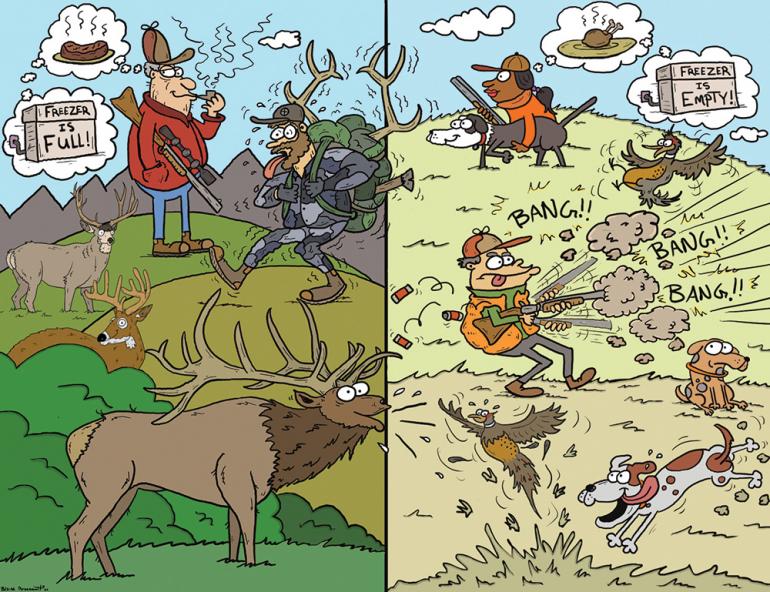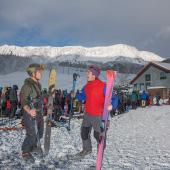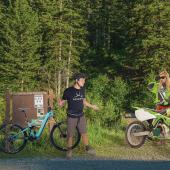Face-Off: Big Game vs. Upland Birds
A hunting showdown.
Hunting has a long heritage in Montana, but its legacy has splintered from sustenance to subculture. Upland-bird hunting and big-game hunting are two completely different forms of the same practice. From the tactics of the stalk, to the food put on the table, to the type of folks in each tribe, ruptures are obvious. But before lending credence to one custom over another, we must measure them with a strict template of principles. Let’s see what happens when big game and upland birds face off.
Glory
There’s something undeniably nostalgic about walking a wheatfield with your dog, swinging a 12-gauge double-barrel at a flushing rooster, your enthusiastic four-legged companion finding it and bringing it back. But a heavy-antlered, 800-pound bull elk, screaming his testosterone-fueled rage at close range? No contest.
Edge: Big Game
Terrain
Chasing elk through pristine alpine country, glassing for antelope in vast untouched prairies, stalking whitetail in fertile river bottoms… big-game country is God’s Country. But the wide-open fields where pheasants flush, the undulating sagebrush of sharptail habitat, and the forested slopes holding fat blue grouse? It’s every bit as wondrous to wander on foot.
Edge: Tie
Attire
Although a few no-nonsense old-schoolers still sport blue jeans when big-game hunting, the pendulum has long since swung to expensive, full-coverage camo, which the trendiest hunters refer to as a “stealth system.” Although historic images of bird-hunting involve austere aristocrats in tweed suits, we Yanks have gradually toned it down, with most upland hunters eschewing any kind of uniform altogether. In hunting, “keeping it real” counts.
Edge: Upland Birds
Marksmanship
Shooting accurately with a scoped, high-powered rifle takes practice, but once you’ve spent some time at the range and gotten comfortable with your weapon, there’s no reason not to get a first-round hit on an ungulate out to 300 yards. But you can spend your whole life swinging a shotgun at fast-moving birds and find that it never gets any easier. Watching spent shells pile up with nothing to show for it—that’s a bummer indeed.
Edge: Big Game
Pack-Out
It’s a great feeling to load a mule-deer hindquarter on your back and hike your trophy back to camp. That is, until your back and knees start to give out on the second trip in the dark, and you still have the heaviest load to go. The average weight of a Hungarian partridge is one pound. Sharptails, two pounds. Shoot a limit of each and you barely have the equivalent of muley backstraps.
Edge: Upland Birds
Success Rate
Combing the hills and grasslands in search of winged game is difficult, no doubt—controlling the dog, beating through brush, all in the hopes of stumbling upon a hapless fowl somewhere out there in the great wide open. But sneaking up on a herd of alert antelope can be as frustrating as teaching kindergarteners quantum theory. Either way, unless you’re diligent, careful, and lucky, it probably ain’t gonna happen. Bird or beast, hunters just as often come home empty-handed.
Edge: Tie
Food
While butchering big game is time-intensive, there’s a reason for it—a kill fills the freezer. Roasts, steaks, burger, sausage, and some for the neighbors, a big-game harvest will make you feel like royalty. A limit of roosters serves up three dinners; filling an elk tag will feed you and your family all winter.
Edge: Big Game
Score: 3-2
Winner: Big Game
And the winner is Big Game, edging out Upland Birds by a narrow margin. It’s a fitting result—one can chase birds just about anywhere, but Montana’s splendid array of ungulates is a rarity indeed, making the pursuit that much more special.














